Analyze the Situation
Description |
The first step towards Team Problem Solving is Analyzing the Situation. The stakeholders are the key players and decision makers in this area of the problem solving process.
Questions like:
“What is/is not happening with respect to the problem?”
“What is not working?”
“What is the Real Problem?”
will be answered and discussed by the stakeholders. The stakeholders will also need to verify what the potential root causes of the problem are.
In conclusion of the analysis, the stakeholders will be:
1) able to agree on the situation and
2) willing to develop changes in order to bring resolution to the problem.
Process Flow Diagram

Procedures
Purpose
The goal!
To generate Symptoms which involves identifying issues from all relevant perspectives. Issues reflect what is ⁄ is not happening, including measurable indicators of success.
Help: Initiating Symptoms is analogous to focusing on the “tip of an iceberg.”
Why do it?
Without an awareness of the apparent issues and documentable indicators from each stakeholder’s perspective, there is little likelihood of gaining a shared problem understanding.
What to do:
With the Problem Solving document open to Symptoms, ask the stakeholders the question “What is ⁄ is not happening?” with respect to the problem you are trying to solve.
Decision:
Has the team generated enough information to move forward?
Responsibility
Team leader
Before you begin
You must have your Problem Solving FrameTEC document open. If you do not, go to the Process Overview for Analyze Situation and follow the instructions in Setting up the framing template or click on the link in the Tools section below.
Procedure
Follow these steps to identify the symptoms of the problem:
Follow these steps to identify the symptoms of the problem:
Step
Action
1
Press ALT + TAB to display your Problem Solving document.
Result: You move between your Browser and the framing document.
2
Scroll to the Symptoms section.
3
Type a list of initial issues and indicators by either sharing (presenting or reviewing) and / or creating (brainstorming or expanding) ideas about what is / is not happening in the specific situation.
Example
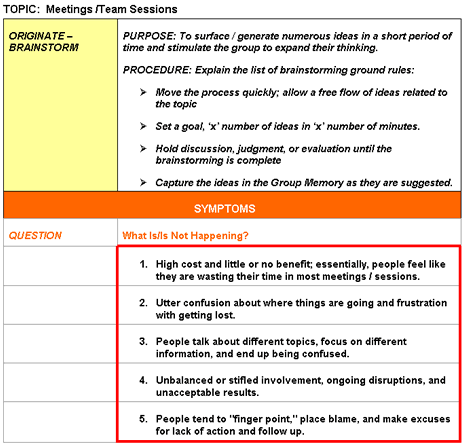
Tools
The goal!
To understand Problems in order to define what is not working with respect to symptoms.
Help: Problems are analogous to “the iceberg just below the surface.”
Why do it?
Understanding Problems ensures a shared focus on the reason(s) for the status of the symptoms. The fact is “if you don’t agree on the problem, then you won’t agree on the solution.”
What to do:
With your Problem Solving document open to Problems, ask the stakeholders the question “What is not working? What is the Real Problem?” with respect to the problem you are trying to solve.
Decision:
Has enough information been generated to move forward?
Responsibility
Team Leader
Procedure
Follow these steps to define what is not working and gain further understanding of the problem:
Step
Action
1
Press ALT + TAB to display your Problem Solving document.
Result: You move between your Browser and the framing document.
2
Scroll to the Problems section.
3
Review, group, and categorize the identified symptoms.
4
For each symptom, use the Clarify-Understanding tool to retype them as problems by defining “what is not working?” and “what is the real problem?”
5
Perform a Force Field Analysis to deepen understanding by noting forces supporting and resisting resolving these problems.
Example
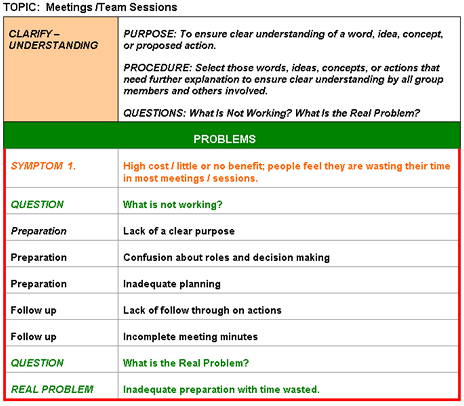

Tools
FrameTEC-MS Word
Purpose
The goal!
To answer the important question of “why it is not working?“
Help: Value Causes are analogous to “an iceberg deep below the surface.”
Why do it?
Valuing Causes facilitates being able to resolve problems and prevent their reoccurrence.
Addressing causes keeps us from continually solving the same problems over and over again.
What to do:
With your Problem Solving document open to Causes, ask the stakeholders the question “Why it is not working?” with respect to the problem you are trying to solve.
Decision:
Has enough information been generated to move forward?
Responsibility
Team Leader
Procedure
Follow these steps to answer why the current situation is not working in respect to the problem:
Step
Action
1
Press ALT + TAB to the Problem Solving document.
Result: You move between your browser and the framing document.
2
Scroll to the Causes frame.
3
Prioritize the problems, and systematically consider the documented supporting and resisting forces as options to answering “why it is not working?”
4
Express these causes as criteria or underlying reasons for the problems not being fully resolved.
Example
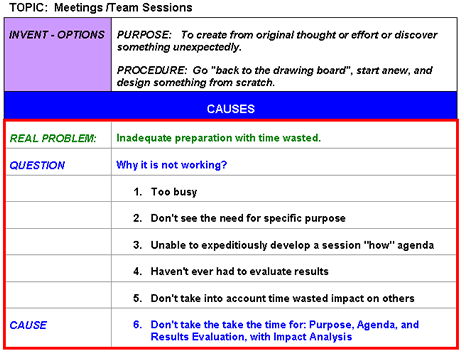
Tools
FrameTEC-MS Word
Purpose
The goal!
To evaluate Root Causes, explaining “why the causes persist and problems have not changed.”
Help: Root Causes are analogous to “base of an iceberg.”
Why do it?
Evaluating Root Causes surfaces and focuses attention on the difficult to discern, underlying mindsets that inhibit improvement.
What to do:
With your Problem Solving document open to Root Causes, ask the stakeholders the question “why, Why, WHY?” with respect to the problem you are trying to solve.
Decision:
Has enough information been generated to move forward?
Responsibility
Team Leader
Procedure
Follow these steps to evaluate the root causes of the problem:
Step
Action
1
Press ALT + TAB to the Problem Solving document.
Result: You move between your browser and the framing document.
2
Scroll to the Root Cause frame.
3
For priority Problems and Causes, type why the causes persist and problems have not changed.
4
Looking across causes, repeat this question.
5
Continue asking “why” several times to delve deep enough to uncover the Root Causes. Translate these into Mindsets to be shifted.
Example
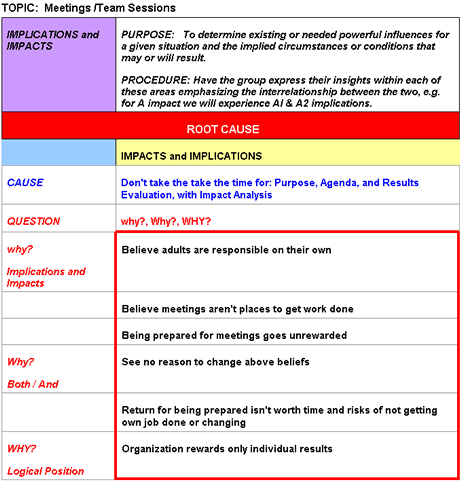
Tools
FrameTEC-MS Word
Purpose
The goal!
To agree on Opportunities, envisioning what is possible for the future.
Help: Opportunities are analogous to “no iceberg.”
Why do it?
Agreeing on Opportunities enables the team to systematically consider potential possibilities, assuming that the problems, causes, and root causes are resolved through creative envisioning.
What to do:
With your Problem Solving document open to Potential Opportunities, ask the stakeholders the question “What is possible in the future?” with respect to the problem you are trying to solve.
Decision:
Has enough information been generated to move forward?
Responsibility
Team Leader
Procedure
Follow these steps to gain agreement on potential opportunities
Step
Action
1
Press ALT + TAB to the Problem Solving document.
Result: You move between your browser and the framing document.
2
Scroll to the Potential Opportunity frame.
3
Either looking in general or for example with respect to each problem, type the answer to “what is possible in the future?”
Important: Be creative and inventive and search for both implications and similarities.
Example

Tools
FrameTEC-MS Word
Purpose
The goal!
To commit to the Desired Results, providing the needed target to work toward.
Help: Desired Results are analogously to the future, “regardless of the iceberg.”
Why do it?
Committing to Desired Results focuses team work and specifies how to measure worthwhile progress.
What to do:
With your Problem Solving document open to Potential Opportunities, ask the stakeholders the question “How will we measure our success?” with respect to the problem you are trying to solve.
Decision:
Has enough information been generated to move forward?
Responsibility
Team Leader
Procedure
Follow these steps to gain commitment to the desired results:
Step
Action
1
Press ALT + TAB to the Problem Solving document.
Result: You move between your browser and the framing document.
2
Scroll to the Desired Results frame.
3
For each potential opportunity, type the measurable outcome for success.
4
Filtering back through the list, retype each idea as initial criteria for success.
Important: Note implications, and confirm agreement and commitment to each.
Example
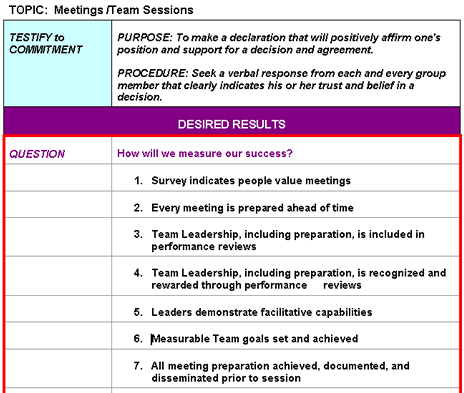
Tools
FrameTEC-MS Word
Purpose
The goal!
To agree on the Situation Analysis in order to indicate a willingness to move forward to changes.
Why do it?
Without this agreement on where we are coming FROM (Symptoms, Problems, Causes, and Root Causes) and where we are going TO (Opportunities and Desired Results), there is little likelihood of reaching agreement on changes.
What to do:
With your Problem Solving document open to Situation Analysis, ask the stakeholders the question “Do we agree on the situation and are willing to develop changes?” with respect to the problem you are trying to solve.
Decision:
Has enough information been generated to move forward?
Responsibility
Team Leader
Procedure
Follow these steps to gain agreement on the Situation Analysis:
Step
Action
1
Press ALT + TAB to the Problem Solving document.
Result: You move between your browser and the Framing Document.
2
Scroll to Situation Analysis frame.
3
Review and categorize the preceding Situation Analysis for each core problem in a FROM –> TO format.
4
Confirm understanding and agreement to move forward with this information to Develop Implemental Changes.
Example
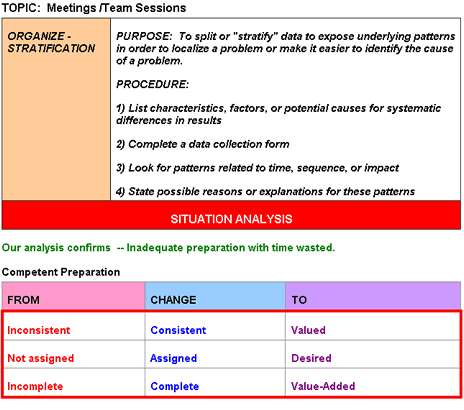

Tools
FrameTEC-MS Word
 FrameTEC – Problem Solving Template
FrameTEC – Problem Solving Template